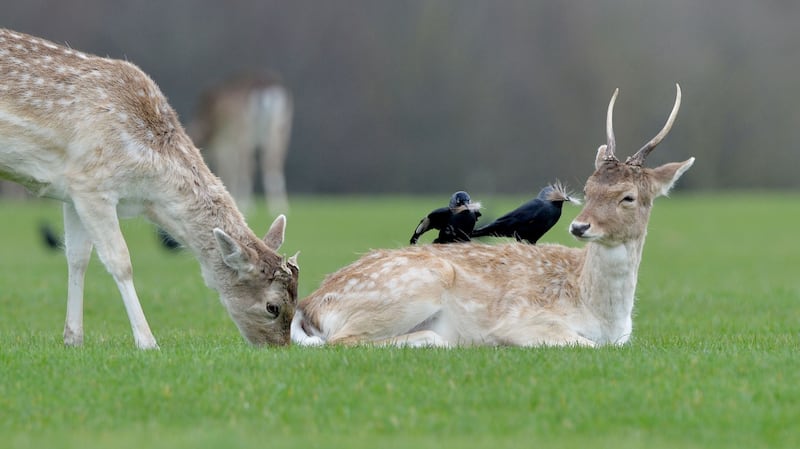Dog owners have been encouraged to leave clumps of their canine’s hair in their back garden to make it easier for birds to find the materials needed to build warm, insulated nests for their offspring.
As that grand stretch in the evening continues as we head into April, birds are increasingly on the lookout for sticks, leaves and often animal hair to build a safe nesting space for their eggs. While most smaller birds rely on softer items that have been discarded such as old cotton wool and feathers to insulate these nests, crows tend to head straight for the source, often landing on the backs of deer and sheep to gather the necessary construction materials.
A photograph printed in Monday's Irish Times shows a fallow deer resting calmly in Dublin's Phoenix Park, totally unperturbed by the three large crowds busily plucking hairs from its back. "The deer are probably quite pleased with the crows," explains Niall Hatch of Birdwatch Ireland. "They're moulting, coming out of their winter coat, and that can be quite itchy. The crows are actually providing a service for them."
Crows also use clumps of sheep wool and dog hair to build their dome shaped nest which includes a protective roof over their eggs. “They wouldn’t land on a dog but I’d recommend people who have a very shaggy dog to leave out clumps of hair. Not just crows will use it, many other birds will take the hair. Birds aren’t fussy, as long as it’s warm and insulating.”
Unlike other birds, crows are smart “opportunists” who will use almost any material to build up their nest high in the trees, says Mr Hatch. “Some birds are very specific but crows will use whatever they can find. Crows taking shiny objects is not as common as people are led to believe but it does happen and they’re stimulated by things they find amusing. Anything that insulates will do the job be that hair, feathers, foam, fluff or cotton wool.

Weather
As female birds continue to nest over the coming weeks the male species will be kept busy singing from the early hours of the morning, says Mr Hatch. “The number of daylight hours affects birds’ breeding hormones and puts them into breeding mode so they start singing more and develop the instinct to build nests. That’s how the cycle works.”
While robins are traditionally the only birds to sing year round, this winter’s relatively mild temperatures led to the unusual occurrence of varied bird song as early as January. “Usually if someone hears a bird in December it’s a robin but we had reports of blackbirds, song thrushes, mistle thrushes and wrens singing this winter. We even had reports of robins nesting in January.”
Mr Hatch says he is not worried by the early arrival of birdsong this winter saying any birds who lost eggs in the cold spell that followed could nest again. “What we would worry about would be if this pattern kept changing over a number of years in a row, that would point more to climate change. The unpredictable weather that comes with climate change does make it more difficult for birds.”
The good news for nesting and songbirds is the mild and sunny weather is expected to stick around throughout this week, with daytime temperatures ranging between 11 to 16 degrees.
Night time temperatures will drop below freezing to -1 in some places early in the week with widespread frost but they’re set to slowly rise later in the week. Cooler weather is forecast for the weekend with drizzle and light rain on Saturday but brightening up on Sunday.













